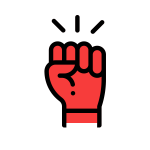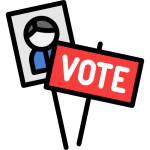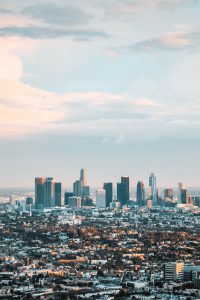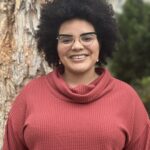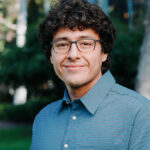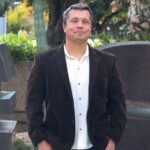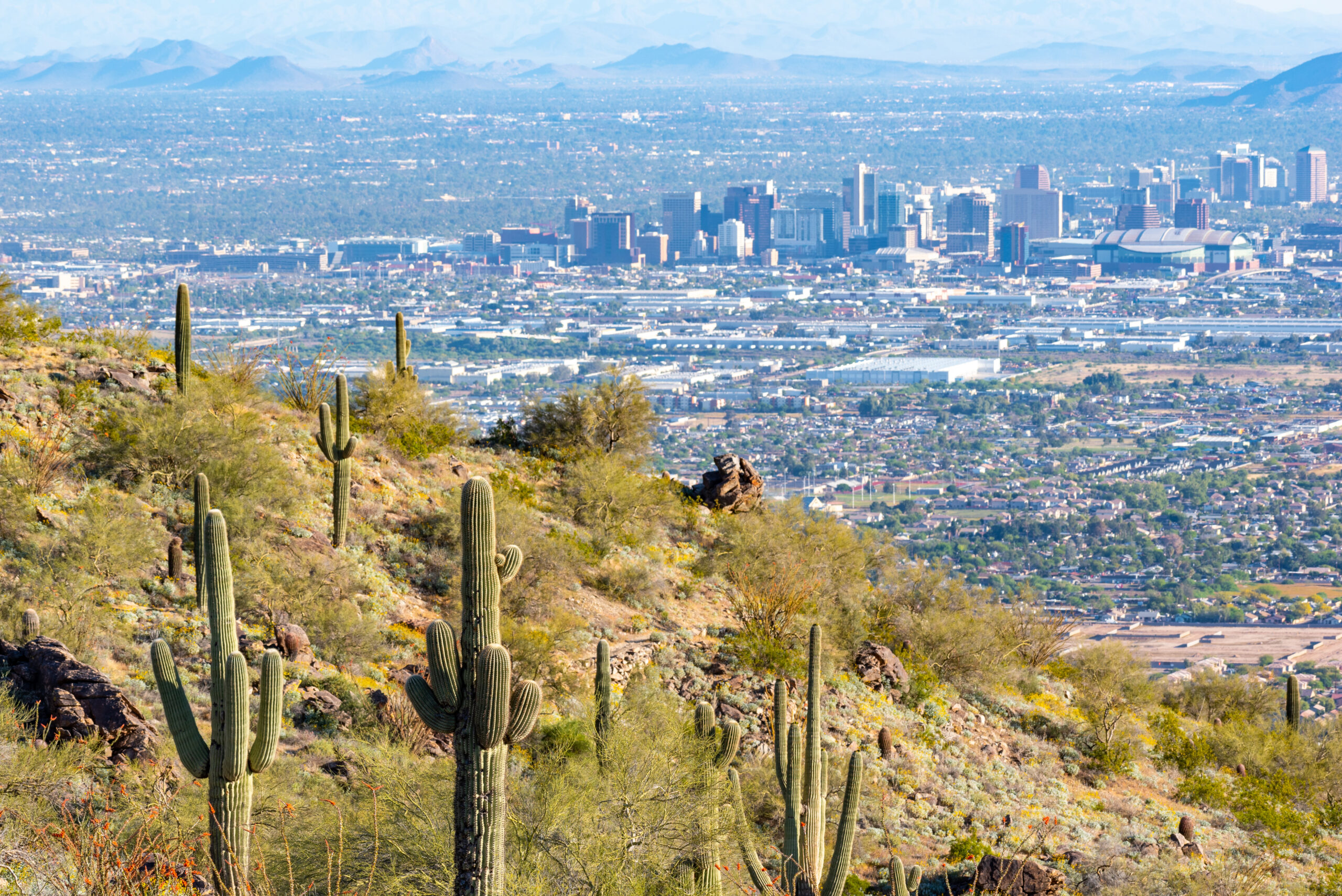
Building Stronger Communities: Insights from Local Economic Development Efforts in South Phoenix
Featured photo credit: Gregory Clifford.
Executive Summary
Crises often expose and deepen longstanding vulnerabilities in undercapitalized communities, leaving many without access to critical resources. In response to the COVID-19 pandemic, community-based organizations (CBOs) across the U.S. quickly mobilized to meet urgent needs while continuing long-standing work toward neighborhood equity and community control.
This case study examines the economic and public health impacts of the COVID-19 pandemic on residents and small businesses in South Phoenix’s South Central Corridor Transit-Oriented Community (TOC), a historically Latino and racially diverse neighborhood shaped by redlining, environmental racism, and systemic disinvestment.
South Phoenix has long been a community with deep cultural roots, a strong tradition of small business ownership, and a legacy of resistance. Residents and business owners face barriers tied to race, language, and immigration status, which contributed to higher COVID-19 exposure and barriers to accessing federal relief. At the same time, the neighborhood continues to face development pressure and environmental risks. Despite these challenges, this case study showcases the powerful, resident-built networks of care, advocacy, and resilience that continue to shape the future of the community.
To understand South Phoenix, we used quantitative and spatial data analysis, paired with historical research and three interviews with staff at local CBOs including the South Central Collaborative, Raza Development Fund, Arizona Community Foundation, and Chicanos por la Causa.
Using quantitative data, we find:
- Low homeownership and high housing costs: Only 46% of households in the South Phoenix study area own their homes (vs. 57% in Phoenix and 65% countywide), and over half of renters spend more than two-thirds of their income on housing.
- Elevated environmental burdens: All census tracts in the study are federally designated as disadvantaged, with higher-than-average air pollution exposure compared to the county.
- Higher COVID-19 impact: Case and death rates outpaced countywide levels between 2020 and 2023.
- Modest business decline but stability in microenterprises: From 2019 to 2023, the number of businesses fell 1% (vs. a 9% growth countywide), with most establishments (70%) employing fewer than 10 people.
Qualitative findings from historical research and CBO interviews highlight how South Phoenix leaders responded to these challenges through three interlinked strategies:
- Educating and equipping residents to shape development: Collaborative networks embedded community input into transit and economic planning. CBOs trained residents through hands-on engagement and technical expertise so they could navigate complex regulatory processes and influence decisions from design to implementation.
- Leveraging trusted intermediaries to sustain local businesses: Community development financial institutions (CDFIs), such as Chicanos por la Causa and Raza Development Fund, provided culturally attuned capital access, technical assistance, and wraparound services, especially critical for entrepreneurs excluded from traditional relief programs during COVID-19.
- Adapting and collaborating in challenging political climates: Local leaders demonstrated agility in addressing shifting crises, from supporting unaccompanied minors at the border to building unlikely alliances for immigrant services, while maintaining a focus on racial equity and community vision.
Decades of exclusion have left South Phoenix underserved, but coalitions of residents, nonprofits, and public agencies are advancing policy reforms and investments that put community priorities at the center. The South Phoenix experience offers a model for community-led revitalization, one where participation is codified, trusted intermediaries bridge access gaps, and advocacy continues even in politically hostile environments. Achieving lasting change will require policymakers, funders, and financial institutions to move beyond symbolic inclusion and commit to sustained partnerships that match the scale of community vision and lead to policy and systems change.
Introduction
Times of crisis expose and can worsen long-standing vulnerabilities in undercapitalized communities. During the COVID-19 pandemic, historically disinvested communities experienced disproportionate levels of business closures,1 unemployment,2 and housing instability.3 South Phoenix, a longstanding majority-Latino neighborhood and community of color in Phoenix, Arizona, exemplified these patterns, having long faced disinvestment due to structural racism and zoning laws that uphold segregation.
In response to the pandemic, Latino-led organizations across the U.S. quickly mobilized to fill governance and service delivery gaps and meet the critical needs of vulnerable members, particularly those excluded from or unable to access government relief programs such as the Paycheck Protection Program (PPP).4 From shaping transit projects to reflect local needs, to helping small businesses stay open, expanding housing options, and building partnerships that bring investment to long-overlooked areas, South Phoenix Latino-led organizations worked to ensure growth benefits the whole community.
These interventions go beyond crisis response—they represent durable, scalable models for advancing economic inclusivity amid shrinking public resources. However, few studies have sought to tell the stories of the community-based grassroots efforts that often sustain communities through crises. This brief combines quantitative data, historical context, and cultural narratives to document how Latino-led, community-rooted strategies in South Phoenix deliver immediate relief while building the structural power needed for long-term inclusion.
About this Case Study
This case study is part of a series documenting Latino-led Economic Development (LLED) efforts. We define LLED as community-rooted strategies that foster economic resilience and justice through advocacy, education, access to capital, and cultural preservation initiatives. Latino leaders and organizations lead LLED efforts to ensure equitable participation and influence in the economy. These efforts are often rooted in the belief that communities can shape their economic futures through grassroots solutions centered on their cultural values and needs while fostering economic self-sufficiency.
In South Phoenix, LLED strategies emerged as a vital response to the compounding challenges of disinvestment, displacement, and the COVID-19 pandemic. This case study explores how community-led efforts in South Phoenix delivered immediate relief through mutual aid, business support, and cultural organizing while building towards long-term empowerment and local ownership in a predominantly immigrant and person of color community. These community-driven interventions supported immigrant entrepreneurs, strengthened informal advocacy networks, and addressed socioeconomic disparities.
To examine community-led interventions in South Phoenix’s South Central Corridor, we combined quantitative and spatial data analysis with historical research and in-depth interviews with three established nonprofit leaders. These included Anne Medina-Doak, previously a U.S. Senate legislative aide, government relations director at Raza Development Fund, and director of policy at the Arizona Community Foundation;5 José Martínez, executive vice president of economic development at Chicanos por la Causa;6 and Shannon Scutari, policy consultant and leader of the South Central Collaborative.7 While limited in number, these interviews provide valuable practitioner perspectives that help contextualize our findings, especially when interpreted alongside longitudinal demographic and environmental data (see Appendix for additional details on methodology).
Traditional economic development often relies on top-down solutions and overlooks cultural and local knowledge, leading to displacement and gentrification where revitalization was promised. In contrast, community-led strategies in South Phoenix empower the local community through education, incorporate community needs into tailored projects, and build vast cooperative networks, paving the way for sustainable, community-centered growth for generational residents.
South Phoenix’s Histories and Context
A. Legacies of Racial Segregation and Disinvestment in South Phoenix
To understand how South Phoenix endured the COVID-19 crisis, we must first recognize its long history of racial segregation and disinvestment. For almost 1500 years, the Hohokam Indigenous communities built a vast 135-mile canal system in the Salt and Gila River valleys to divert water into the area, which is the foundation for Phoenix’s modern irrigation system. The system transformed the desert into farmland and supported major villages such as Pueblo Viejo (Old Town). These indigenous groups vacated the region due to environmental and societal pressures by the 15th century, leaving behind extensive archaeological remains.8
Early land speculators such as Jack Swilling repurposed these historical canals to build the irrigation systems that would bring water to the area, establishing the City of Phoenix in 1868.9 The same year, the South Central Corridor was established when fellow speculator Columbus H. Gray’s family arrived and settled at 7th Avenue and Mohave, purchasing hundreds of acres of land in the area for themselves and the family of Mary Green, a formerly enslaved woman employed by the Grays. Mary Green and her descendants would go on to be some of the first Black settlers of the Arizona territory.10
The recent COVID-19 pandemic punctuates a long history of exposure to communicable diseases in Arizona. This history stretches back to smallpox and measles introduced by Spanish conquistadores and missionaries that devastated indigenous communities, to the mix of small pox, tuberculosis, and other maladies brought by colonizers under the banners of an independent Arizona territory and later the United States. The same territory and climate that attracted entrepreneurs also appealed to health care practitioners who established sanatoriums for tuberculosis.11
Mexican communities were essential to the establishment of early Phoenix, with many Sonoran families migrating to the area for work such as building the canal system, farming, and constructing adobe homes in the area. While some were able to establish themselves as entrepreneurs, Mexican workers were excluded from many economic sectors and limited to low wage agricultural jobs.12 By 1877, Latinos accounted for almost half the population in Phoenix.13 But as national railway connections expanded in the 1890s, the region saw an influx of white, Black, and Asian residents drawn by new economic opportunities. Over time, Latinos and other non-white populations were pushed into lower-wage jobs in meatpacking and warehouse industries, often concentrated south of the railroad tracks.14
By the 1920s, housing covenants and discriminatory lending practices made it nearly impossible for African Americans, Mexicans, and Asians to buy property north of Van Buren Street, creating a de facto racial boundary along the railroad tracks. Up until 1960, half the African Americans in Phoenix lived south of downtown.15 Nevertheless, communities of color, including Black veterans and several Japanese families rebuilding their lives after internment, continued to settle in the South Phoenix area after World War II in pursuit of opportunity.16 Some achieved economic stability and built strong community networks that played a critical role in local civil rights efforts. Still, the color line persisted, with Black, Brown, and Asian communities’ residents facing persecution and discrimination throughout Phoenix, including formal racial segregation and violence.17
As in many American cities, early 20th century development in Phoenix prioritized White urban centers and emerging suburbs, while many White families moved outward to escape “undesirable” minority neighborhoods.18 In the 1970s and 1980s, freeway construction and airport expansion displaced thousands of Latino families from West Phoenix into South Phoenix. This long history of discrimination, segregation, and disinvestment is largely the reason persistent poverty remains an issue in much of South Phoenix today.19 The South Central Corridor and surrounding area of South Phoenix remains an important site of cultural and community capital for Phoenix’s Latino community and other small but thriving Black and Asian communities.
B. Location and Cultural Identity of South Phoenix
Residents today define South Phoenix as the area between 48th Street and 19th Avenue, bounded by the South Mountains to the south and the Salt River to the north.20 For this report, the South Phoenix study area includes the census tracts outlined in Map 1. This area represents a segment of the South Central Transit-Oriented Community (TOC) corridor, where a five-and-a-half-mile light rail extension was recently completed in June, 2025 (The South Central Extension/Downtown Hub). The Hub connects downtown Phoenix to Baseline Road, running along Central Avenue, and will include new stations, a downtown hub, and integrated public art. Although the light rail project was only recently completed in June 2025, the business dynamics observed between 2019 and 2023 may already reflect some of the early impacts of construction and corridor investment.
Map 1. South Phoenix Study Area Census Tracts Used in Analysis, with Public Light Rail Transit Route Overlay

Source: U.S. Census Bureau, 2020 Cartographic Boundary Shapefile; OpenStreetMap.
Neighborhood Conditions in South Phoenix Today
A. South Phoenix’s Population Shapes Its Cultural Strategy
Overall, the South Phoenix study area is a majority-Latino, lower-income community with a high share of renters and limited economic resources. These characteristics make it particularly vulnerable to displacement pressures and in need of equitable investment as the light rail extension progresses. The demographic profile helps explain why many efforts in the community prioritize education and knowledge building, while also being sensitive to the diverse cultural needs of the community.21
The South Phoenix study area is a predominantly Latino community, with 81% of residents identifying as Latino, nearly twice the share in Phoenix (42%) and over two-and-a-half times the share in Maricopa County (31%). The Latino population, like in the rest of the county, is primarily of Mexican descent.22 Other racial and ethnic groups are present in smaller proportions, with Black residents making up 9% of the population and very few residents in the study area identifying as Asian or white.
Table 1. South Phoenix Study Area Racial and Ethnic Composition, 2023
Note: Latinos can be of any race. All other groups reflect the non-Latino/non-Hispanic population.
Source: LPPI analysis of 2023 5-Year American Community Survey Table B03002, available online.
South Phoenix’s immigrant roots are central to its cultural and economic vitality. One in four residents in the study area are noncitizens—above the city (22%) and county (17%) rates—and one in three residents are foreign born. In 2021, 41% of children under five lived in households with at least one foreign-born parent. Spanish is widely spoken across the area, with 59% of households using it at home—over double the share in Phoenix and three times the county rate. These patterns highlight the importance of language access and culturally responsive strategies.
Table 2. Nativity and Linguistic Diversity in the South Phoenix Study Area, 2023
Note: Limited English proficient households are defined by the U.S. Census Bureau as those in which no member 14 years or older 1) speaks only English or 2) speaks a non-English language and speaks English “very well.”
Source: LPPI analysis of 2023 5-Year American Community Survey Table B05001, available online; Table B05003I, available online; and Table C16002, available online.
Educational attainment gaps in the South Phoenix study area reflect long standing structural barriers. Nearly 4 in 10 residents lack a high school diploma, more than twice the rate in Phoenix and over three times the county average. Only 10% hold a bachelor’s degree or higher, compared to one third of residents city- and countywide. These gaps point to the need for targeted investments in education and workforce development.
Together, these demographic patterns point to the value of community strategies that strengthen educational access, improve communication across languages, and reflect the community’s cultural context. Many CBOs in the area are Latino- or minority-led, and prioritize strategies that reflect the area’s cultural diversity and address the most essential needs. Local service providers find creative ways to ensure that programming is accessible to all in the community. In South Phoenix, this cultural fluency is not just about identity. It is a practical, appropriately-tuned approach that supports workforce readiness, small business success, and long-term neighborhood stability.
Figure 1. Educational Attainment for the Population Ages 25 and Older in South Phoenix Study Area, 2023
Source: LPPI analysis of 2023 5-Year American Community Survey Table B15003, available online.
B. Homeownership Gaps Underscore the Need for Equitable Investment
South Phoenix faces persistent housing and income disparities. Median household income in the study area is just above $45,400—only 59% of the city median and 53% of the county median (Table 4). While median rent in South Phoenix ($1,100) is lower than city and county averages, it still poses a significant burden relative to local incomes.
The homeownership rate is lower in the South Phoenix study area than in the city or county. Just 46% of households own their homes, compared to 57% in Phoenix and 65% in Maricopa County. Most households are renters (54%), reflecting limited opportunities for wealth-building through homeownership even for generational residents. According to the City of Phoenix’s South Central Transit Oriented Development (TOD) Plan, most renters spend most of their earnings on housing and transit combined. Mobile home parks make up a sizable portion of the local housing stock, reflecting the area’s unique and often vulnerable housing landscape.23
Table 3. Homeownership and Income Indicators for South Phoenix Study Area, 2023
Source: LPPI analysis of 2023 5-Year American Community Survey data.
Historically, public policy decisions systematically excluded Black, Latino, and Asian families from access to credit, mortgages, and desirable neighborhoods.24 These exclusionary practices limited the ability of families of color to build intergenerational wealth and laid the groundwork for ongoing disparities in homeownership rates seen today.25 As a result, Black homeownership in Arizona has declined significantly over the past 50 years and Latino homeownership was hit especially hard by the 2008 recession.26
While most residents rent, South Phoenix is also home to long-standing homeowners who often pass their properties down through generations.27 The community’s housing stock—ranging from post-WWII single-family homes to multifamily units and mobile homes—faces growing maintenance needs due to aging structures and limited reinvestment.28
Meanwhile, rising housing and rental prices have made it increasingly difficult for residents to afford or remain in their homes.29 Despite Phoenix’s rapid growth, affordable housing production has not kept pace with demand. As of the latest estimates, only 20 affordable units exist for every 100 extremely low-income renters, and average rents have increased 28% since 2019.30
C. Environmental Injustice and Public Health Risks in South Phoenix
South Phoenix has long-born environmental harm due to its proximity to railroads, industrial zones, and underinvestment in basic infrastructure.31 From the 1890s onward, the area faced recurrent flooding and sanitation issues with limited municipal intervention, leading to the area’s often combative relationship with local government.32
This pattern continued through the 20th century as the construction of the I-10 and I-17 freeways in the 1970s and 1980s further divided the neighborhood and exacerbated air pollution.33 In the 1980s, the Estes Landfill, located along the Salt River near Sky Harbor Airport, was identified as one of Arizona’s first toxic waste sites, where contaminants including vinyl chloride, trichloroethylene, and barium were found. Despite over $1 million spent on testing in the 1990s, the full extent of groundwater contamination remains uncertain.34
Health disparities in the region reflect these cumulative risks as residents have long dealt with pollution and its effects on their health. As shown in Table 5, South Phoenix residents face higher exposure to Particulate Matter 2.5 air pollution compared to the county.35 All census tracts in the South Phoenix study area are designated as disadvantaged under the federal Climate and Economic Justice Screening Tool (CEJST 2.0), highlighting the area’s disproportionate environmental and socioeconomic burdens. The stark 14-year life expectancy gap between South Phoenix and more affluent areas such as North Scottsdale may be partially attributable to these disparities, along with limited access to health care.36
Table 4. Environmental Indicators for South Phoenix Study Area
Source: LPPI analysis of archived CEJST data, accessed August 2025.
Community advocacy has played a central role in pushing back against environmental injustice. In the 1990s and early 2000s, local organizations mobilized against the clustering of hazardous waste facilities near residential areas.37 By 1999, 14 of these sites existed within metro Phoenix, with eight sites situated in South Phoenix close to the railroad.38 In the early 2000s, residents protested in response to the proposed expansion of the Innovative Waste Utilization (IWU) in South Central, especially after several prominent spill incidents and a lack of sufficient response by the local government.39 This activist effort sparked citywide conversations on language access, oversight, and community inclusion as the local Spanish-speaking community had largely been left out of public meeting access.40
More recently, extreme heat and limited green space have become urgent concerns. Urban heat island effects make the South Central Corridor hotter than surrounding areas due to paved surfaces and lack of trees,41 including tree coverage far below the city established goal of 25% canopy cover by 2030.42 While over half of residents live within a quarter mile of a park, many local parks lack recreational buildings or year-round programming, highlighting the need for deeper investments in equitable green infrastructure.43
D. A Small Business Economy and Community Entrepreneurship
Small businesses in South Phoenix are an essential part of the community’s power. Despite a long history of disinvestment, South Phoenix is home to a network of local businesses, many of which are owned by the local Latino community and other entrepreneurs of color. This includes generational businesses that have called the area home for decades.44 The South Phoenix study area business landscape is dominated by very small establishments, with 70% of all businesses being microbusinesses (between one and nine employees). Businesses with 10 or more employees make up only a small portion of the area’s business community.
In 2023, there were 532 businesses in the study area, with a high concentration of retail, healthcare, and local services. The largest industry sector was health care and social assistance which made up 18% of all establishments, followed closely by retail trade (17%). The annual purchasing power within half a mile of the corridor center is estimated at $250 million, and within 2 miles it is about $2 billion.45
Other notable sectors include:
- Other services (12%), including personal care, maintenance, and nonprofit services;
- Accommodation and food services (7%);
- Finance and insurance (6%) and real estate (5%), reflecting modest professional and property-related activity; and
- Construction (4%) and educational services (3%).
This industry mix reflects a community-oriented business environment focused on essential services, food, and care industries, rather than high-growth or high-tech sectors. Community assets include beloved restaurants, community centers, schools, markets, and places of worship. Many artists and cultural practitioners also call the area home and remain essential to the infrastructure. The industry composition suggests that the corridor is primarily home to neighborhood-serving businesses, many of which may be sensitive to the impacts of infrastructure development such as the light rail project.
Local residents have been fighting to ensure the historical and cultural legacy of the area is preserved through stories and interviews with longtime residents and business owners against the backdrop of recent development efforts. In 2017, students and affiliates at local South Mountain Community College collected hundreds of these interviews as part of the South Phoenix Oral History Project, including a driving tour of local businesses.46
Many of the family-run industries on the tour have been in the area since the 1950s and are part of a legacy of Black, Brown, and Asian families seeking opportunity in the American Southwest. These small businesses are currently struggling to survive due to a lack of business support targeting the local area, rising housing costs forcing area workers to live farther away and driving up retail rent prices, and light rail construction deterring customers.47 While programs such as Local First Arizona48 and targeted grants for those affected by the construction have offered some assistance, some of this relief has expired despite delays to the light rail’s predicted completion date.49
Figure 2. Industry Mix of Businesses in the South Phoenix Study Area, 2023
Note: Industries reflect two-digit NAICS sectors.
Source: LPPI analysis of 2023 Data Axle data.
COVID-19’s Impacts on South Phoenix
The pandemic exposed deep-rooted inequities in health, access, and opportunity in South Phoenix, like in many predominantly Latino communities across the nation. High infection and death rates were driven by limited healthcare access, environmental risks, and systemic disinvestment.
A. Addressing COVID-19 Disparities Through Community-Driven Partnerships
In the first year of the pandemic, COVID-19 deaths in South Phoenix were among the highest in the region (Figure 3). Based on data from the Maricopa County Department of Public Health, the combined COVID-19 case rate across the zip codes covering the South Phoenix study area was about 39,000 per 100,000 residents—higher than the countywide rate of roughly 33,800. The death rate in South Phoenix was about 454 per 100,000, compared to 413 countywide. COVID-19’s impact was also felt in other Latino-majority neighborhoods across Phoenix, such as Maryvale, particularly during the summer surge but throughout the whole pandemic.50
Figure 3. Cumulative COVID-19 Case and Death Rates in South Phoenix, 2020-2023
Source: Maricopa County Public Health Department (cumulative cases and deaths reported between January 22, 2020 and December 31, 2023); population estimates from 2019–2023 5-year ACS.
Note: These figures reflect cumulative confirmed and probable cases and deaths reported between January 22, 2020, and December 31, 2023. South Phoenix is defined using zip codes/ZCTAs: 85040, 85041, and 85042.
These catastrophic rates can be attributed in large part to disparities in vaccine access. Arizona Department of Public Health data showed differences in vaccination rates across demographic groups. May 2021 data show that approximately 1.4 million white residents had received at least one dose of the COVID-19 vaccine, compared to about 390,000 Latino or Hispanic residents. Smaller numbers of Asian and Pacific Islander, Native American, and Black residents had received at least one dose.51
Local activists, many motivated by deaths in their own families, successfully pushed lawmakers for vaccination sites in partnership with CBOs in West and South Phoenix. These efforts demonstrate the power of community advocacy and public-private partnerships in the area.52 CBOs also filled critical language gaps by providing public information in Spanish, helping counter earlier misinformation UnidosUS alone reported administering about 15,000 vaccinations in South Phoenix neighborhoods. By comparison, the wealthier Scottsdale zip code reported about 29,000 doses administered.53 South Phoenix residents reported a lack of testing sites, especially those offering services in Spanish, and long wait times at the few clinics that were available.
Many families in South Phoenix faced heightened hardship in the early months of COVID-19 due to limited access to reliable medical care. Despite decades of advocacy for a full-service hospital, the area is still served only by a few small community clinics, often located far from where residents live.54 During the pandemic, clinics encouraged residents to seek available services but wait times for critical care and transfers to larger hospitals were long. High uninsurance rates among immigrants further limited access to treatment. For some families, cross-border separations made it nearly impossible to be with loved ones or recover their bodies after they passed.55
B. Post-Pandemic Business Recovery Remains Uneven
From 2019 to 2023, the total number of businesses in the South Phoenix area declined slightly (–1%), compared to a 9% increase countywide. Over this period, 155 businesses opened and 163 closed, with entry (29%) and exit (30%) rates nearly balanced, indicating that new businesses were largely offset by closures. The overall “churn rate,” or combined entries and exits, was lower than the county average (59% vs. 64%). This suggests a relatively stable base of long standing establishments but stagnant or slower post-pandemic recovery.
Many of these businesses are micro-enterprises deeply rooted in the community, making them vital to the corridor’s economy yet highly vulnerable to economic shocks. As a U.S. Senate Legislative Aide at the time with close ties to the Latino community, Anne Medina-Doak explained these numbers reflect the true lived realities on the ground:
“We began hearing stories from people at every level, but the most heartfelt came from small business owners and nonprofit leaders who were struggling just to make ends meet. Many of them couldn’t even get through to their banks for help. What stood out was the urgency. It became clear that truly listening keeping our ears to the ground was essential. By elevating their stories and experiences, we were able to speak truth to power and bring their realities directly to policymakers who needed to hear them.”
Her insight underscores the importance of relief programs that are both accessible and designed to reach small, community-rooted businesses, especially those excluded from traditional banking and capital systems.
Figure 4. Business Dynamics in South Phoenix Study Area, 2019 to 2023
Source: LPPI analysis of 2019 and 2023 Data Axle data.
C. Closing Access to Capital Gaps Through Trusted Intermediaries
Stagnant startup rates in South Phoenix reflect not only the pandemic’s impact but also long standing barriers to capital. Decades of loan denials have fostered deep mistrust of large financial institutions among Black, Latino, low-income, and immigrant entrepreneurs.56 As a result, many operate without formal banking or an online presence, leaving them excluded from larger markets and government aid, and vulnerable to predatory lenders.57 Additionally, many immigrant entrepreneurs do not qualify for formal business support, leaving them particularly vulnerable in times of crisis.
The South Phoenix study area received less Paycheck Protection Program (PPP) relief than the county overall—about $2,400 per job and $1,700 per resident compared to $4,400 and $2,100 countywide. Many of the loans that did reach local businesses flowed through trusted intermediaries such as CDFIs and local foundations, which leveraged established relationships to connect the hardest-hit businesses with funding.
As Anne Medina-Doak observed, the Arizona Community Foundation’s COVID-19 Community Response Funds and its existing relationships with local organizations meant they could “get those dollars to those hardest hit areas,” reaching entrepreneurs who “didn’t really know how to access or have a connection to those funds.” While she acknowledged that not everyone who needed help received it, she emphasized that these targeted efforts made a tangible impact for businesses most in need.
Figure 5. PPP Relief Received in South Phoenix Study Area, April 2020-May 2021
Source: LPPI analysis of Paycheck Protection Program loan-level data from the U.S. Small Business Administration (covering loans approved from April 2020 through May 2021), available online. Population data are from the 2017-2021 5-Year American Community Survey. Job data are from the 2019 Longitudinal Employer-Household Dynamics (LEHD) dataset.
The balance of openings and closures suggests the corridor may be positioned for growth now that major infrastructure projects are complete. Construction has strained businesses, and relief grants have largely expired, prompting calls for extensions and stronger enforcement of equitable development commitments. Some small businesses warned throughout construction they would likely not be able to stay afloat waiting for the South Central transit project to be completed and may have been forced to shut down, demonstrating a need for changes in policy and more formal support for local businesses.58
D. Transit-Oriented Development as an Opportunity for a Community-Led Economic Vision
After decades of disinvestment in 2008, the largest light rail construction project in the nation’s history was completed in Phoenix. In 2013, Phoenix adopted the Transit-Oriented Development (TOD) Strategic Policy Framework, which identifies equity as a core element of sustainable transit-oriented planning. In 2016, the City of Phoenix was awarded a federal grant to engage the community and support local businesses along the South Central Avenue light rail extension.59 The South Central light rail extension generated renewed interest in revitalization but also concerns about displacement. As told by Shannon Scutari, a collaborative leader:
“And that’s where the Collaborative was important early on, we could see that without community involvement in decision making, the light rail extension would become a Neighborhood Annihilation Project instead of a Neighborhood Improvement Project. We didn’t want folks displaced in high numbers. We wanted the community it was built for to benefit from it.”
The light rail project remained heavily contested, with powerful national, state, and local pressures turning the project over to voters in 2019, where it overwhelmingly passed and continued forward.60 This strengthened the resolve of residents, business owners, and CBOs, particularly the South Central Corridor Collaborative (launched in 2016), a coalition of 31 organizations that aimed to ensure the project reflected community priorities.61
Collaborative partners—including Promise Arizona, Raza Development Fund, Multistudio, and Phoenix Revitalization Corporation—engaged thousands of residents, knocking on nearly 7,500 doors and collecting 730 surveys to shape a shared “community ownership” vision. Across the many neighborhoods brought together by the light rail, communities developed their own criteria and priority areas for investment, including neighborhood retention, multi-modal streets, parking reductions, walkable urban neighborhoods, and water capture and reuse.62 Together, residents, activists, and the city created a development and infrastructure vision for the corridor that incorporates affordable housing, transit access, social services, green spaces, and support for local businesses and artists. Shannon Scutari explains:
“It was critical for the three South Central Collaborative communities—Warehouse District, Central City South and South Phoenix—to decide how they would partner on a world-class, transit-connected community. It is primarily communities of color south of the railroad tracks and south of the river, and more affluent businesses closer to downtown. Collaborating created the power to ensure the communities connected with the train passed mutually beneficial policies, pooled resources, and shared influence to build the line on their terms.”
The efforts of the Collaborative culminated in the 2022 South Central Transit Oriented Development Community Plan, now recognized nationally as a model for community-led development.63
Residents continue to approach the project with cautious optimism. While they are excited for many of the proposed investments and plans to prevent displacement and keep residents thriving, concerns about how construction would impact businesses in the meantime seem to have been confirmed for some. Residents and activists with the Collaborative have stressed that policies need more enforcement power to ensure that private firms and developers uphold their commitments under equitable development plans and that community input is a required component of the process.
Still, the plan offers a long-term framework for integrated solutions, balancing growth with affordability and cultural identity. With the completion of the light rail project itself in June of this year, now is the time to ensure that the recommendations in the report are put in place to ensure residents are able to benefit from this new access to public transit and the job opportunities it will provide without displacement. As Anne Medina-Doak shares:
“I recognized that there was more of an effort to place people who really cared in positions to respond to the community. I understand the value of the whole ecosystem seeing how important it is for everyone to work together, and it is my hope that we will always remember what we were able to accomplish together and continue to grow it.”
E. Federal Opportunity Zones Are Complementary but Limited
As shown in Map 2, three census tracts in the South Phoenix study area—1154, 1158.01, and 1165—are designated as federal Opportunity Zones, making them eligible for tax incentives to spur long-term private investment in historically undercapitalized neighborhoods. These designations have supported TOD and affordable housing projects in the larger region.64 But research shows Opportunity Zones alone rarely produce significant gains in employment, earnings, or poverty reduction,65 as investments tend to favor wealthier, more educated counties.66
While TOD projects and Opportunity Zone designation projects continue to transform the South Phoenix area to one where both the economy and residents can thrive, local leaders caution that without intentional, enforceable equity strategies, investment may bypass those most in need. As Shannon Scutari argues:
“I realized unless we really have the community involved in the decision making all the way back to the planning and design of the project then there is no way this new extension would improve their communities.”
Map 2. Federally Designated Opportunity Zones in South Phoenix Study Area

Source: U.S. Department of Housing and Urban Development, available online.
Interventions: Building Power, Capacity, and Opportunity from Within
A. Educate and Equip Residents to Shape Economic Development
One of the South Central Collaborative’s most significant interventions both in response to the TOD and later during COVID-19 was establishing a baseline that economic development and services must be shaped through deep, ongoing collaboration with the communities they serve. According to CBOs, one reason for the lack of meaningful engagement was the assumption that community members would not understand the complexity of the plans.
To counter this, the Collaborative made resident education and technical assistance cornerstones of its work, demystifying complex transit and economic development processes so residents could influence decisions from design to implementation. As Collaborative leader Shannon Scutari explains, the model “is about folks from the community understanding all of the technical requirements and regulatory requirements necessary to implement a large infrastructure project…There was a big training, education, and technical assistance focus. There was also a real relationship element to the success.” Without this foundation, she notes, transportation projects “can become very insular and not the type of thing that can improve a community” because residents are not equipped to act at key decision points.
Education efforts were conducted in plain language, often in Spanish, and extended beyond traditional public meetings to include hundreds of surveys, bilingual workshops, needs maps, nearly 70 “road shows,” and dozens of stakeholder roundtables. The result was a model where community participation was not an afterthought but codified into policy and contracts—ensuring that development plans were truly shaped “by and for” the community.
Trust was built by centering Latino leaders and other long-term residents as messengers, countering decades of broken promises and disinvestment. As Jose Martínez of Chicanos por la Causa explains, “What we have is an organization led by a board that’s primarily Latino…people who grew up in the neighborhood and understand the culture. The community knows that we’re looking out for their best interest. [If public] strategy is just hiring someone who speaks Spanish at the lowest end of the organization to do the outreach…that’s not the secret sauce.”
Many of those leading the fight for equitable development in South Phoenix are part of long-standing networks of organizations and coalitions that residents already rely on in times of crisis. Some of the most effective allies have come from outside the Latino community, but they attribute their success to patience, humility, and giving local residents the space to lead. Years of relationship building laid the groundwork for today’s more effective collaborations, offering a model for policymakers, researchers, and philanthropists who want to be true allies in community-led change.
B. Leverage Trusted Intermediaries to Grow Local Businesses
In South Phoenix, local CDFIs and other community-based organizations have been vital to small business survival, particularly in neighborhoods where government intervention has been limited or mistrusted. Organizations such as Chicanos por la Causa and Raza Development Fund have decades of experience providing loans, grants, and operational support to immigrant-owned businesses. During COVID-19, their role expanded to become a lifeline—helping some owners navigate formal government relief programs and funding others who would otherwise have been left out entirely. A key to their success is trust. Many CBOs deliberately limit intrusive questions, ensuring dignity and access for all clients.
Aside from their direct support of small businesses, these organizations provide other wraparound support services such as education, health access, and affordable housing. They see these as essential to not only empowering the owner, but the whole community. Martínez describes their strategy as “hyper focused on small businesses that are the heart of the communities we serve… we help a small business establish themselves or grow…[create] more job opportunities for individuals to actually work in their own neighborhood. We invest through our lending programs so they can thrive, hire individuals in their own community, and build wealth for those owners.”
Outside of supporting business owners, many CBOs in the area are also working to create more job exposure and opportunities for the next generation of Latinos and other students of color. Through innovative partnerships with corporations and learning institutions, CBOs use technology and the interests of young people to get them excited about options they may have previously not thought possible. This also includes supporting learners who may be interested in alternative pathways to success such as trades and entrepreneurship. Often, a key part of these efforts continues to be partnering with role models who look like the children being served, so that they can see new possibilities for themselves in these leaders of similar backgrounds.
C. Adapt and Collaborate in Challenging Political Climates
Supporting Latino and immigrant communities has become increasingly difficult in recent years, particularly in regions with anti-immigrant policies. Yet leaders in South Phoenix have remained resilient, adapting quickly, forming new alliances, and finding ways to meet community needs in shifting political and economic landscapes.
One of the biggest tools CBOs have embraced is flexibility. During the COVID-19 crisis, Arizona and other border states faced the urgent needs of thousands of unaccompanied minors arriving from the Mexican border. While the peak influx occurred in 2019, high numbers continued throughout the pandemic. Because of the trust and relationships they had built over decades, certain CBOs—such as Chicanos por la Causa—took the lead in coordinating care for these youth. At times, they deployed staff to other parts of the state or country to work alongside partner organizations, sharing expertise and ensuring experienced personnel were on the ground where needed. These collaborations strengthened the collective capacity of organizations working in areas with limited government or mainstream support. As Anne Medina-Doak noted:
“I think it really showed the community coming together in a really different way. It transcended…it wasn’t just about political parties, it really was about survival.”
The COVID-19 pandemic also demonstrated that meaningful progress can happen even in unlikely alliances. Latino leaders advocating for immigrant services found unexpected partners among individuals and policymakers who had not previously shown a strong pro-immigrant stance. By bringing constituents’ stories to the forefront, they were able to open minds, spur action, and, in some cases, secure support outside of the legislative process when formal avenues were blocked.
This work was not without opposition. At the same time, South Phoenix advocates—like their peers in other states—shared about the hostility, threats, and well-funded opposition they faced. Still, they persisted, using education and storytelling to shift perspectives, while simultaneously building power within their own networks to advance their goals despite resistance. In this way, they established strong coalitions that were able to keep their vision of the project going, even against wealthy lobbyists hoping to end their efforts.
By balancing engagement with opposition and deepening solidarity among allies, South Phoenix CBOs have learned to both change minds when possible and move forward with power when it’s not. As Shannon Scutari shared,“Somebody just recently read me a passage about loving kindness and about how loving kindness isn’t always nice. Loving kindness is firm as well. You have to make sure you’re approaching things with that loving kindness and being firm, and saying, I really want you to succeed. You can take me down but that’s gonna ripple out. If we support each other, I can help you. And you develop that mutual support.”
Conclusion
The future of South Phoenix will not be secured through speculative development or top-down planning, but through sustained investment in the people and institutions that have kept this neighborhood strong for generations. This community is rich in knowledge, cultural capital, and grassroots innovation—especially among Latino residents and the local organizations that have long provided support. Residents know best what their neighborhoods need. What they lack is not vision, but the resources and policy backing to bring that vision to life.
“Understand that they may not have a background in finance, but they understand the nature of their business and how they’re going to make money doing it. But our community has all the solutions. They have all the ideas. What they need is organizations. They need banks. They need a community surrounding them that’s going to invest in their ideas.” –Jose Martínez
Philanthropic organizations and financial institutions must meet this moment. Too often, Latino-owned businesses and immigrant entrepreneurs are excluded from traditional lending, grantmaking, and government aid. This leaves them vulnerable to predatory lenders and ineligible for critical relief programs, as the COVID-19 pandemic made clear. CDFIs such as Chicanos por la Causa and Raza Development Fund have filled these gaps, but they cannot shoulder the burden alone. Banks and funders must commit sustained, flexible capital to trusted, culturally competent CBOs, prioritizing long-term operating support over one-time recovery grants.
Policymakers must also move beyond rhetoric to enforcement. The South Central TOD Community Plan offers a national model for inclusive, community-driven transit planning, but without strong accountability, the promises of affordability, anti-displacement, and cultural preservation will ring hollow. The city should extend relief for small businesses impacted by rail construction, expand renter protections, and open pathways to homeownership for Latino and Black families locked out of wealth-building for generations.
South Phoenix residents have proven their capacity to lead. Now it is time for institutions to follow—by investing in a future where equity is not aspirational but operational, and where revitalization strengthens, rather than displaces, the communities at its heart.
Acknowledgments
The research team extends its gratitude to Sonja Diaz for setting the project’s vision, Julia Silver for reviewing an earlier version of this report, Alberto Murillo for early literature review support, Jorge Padilla and Bryzen Enzo Morales for research support, and Jared Jimenez for support with cartography. We would also like to thank Anne Medina-Doak, José Martínez of Chicanos por la Causa, and Shannon Scutari of the South Central Collaborative for their time and commitment to this project.
Appendix. Methodology and Limitations
We used a mixed-methods approach combining quantitative and spatial data analysis, historical research, and qualitative interviews. The interviews—limited to three staff members at Arizona CBOs—were not intended to be representative but instead to offer practitioner insight from individuals deeply embedded in Phoenix’s cultural and economic life. These perspectives helped us interpret the broader data trends and identify locally relevant themes. We acknowledge that the small sample size limits the generalizability of the qualitative findings and invite further study to build upon this exploratory case. Future research should include a broader sample of community voices to deepen and validate the themes identified here.
Interviewers asked community leaders about their organization’s background and mission; strategies and stories of COVID-19 resilience; specific needs, values, or opportunities they see as necessary to building a strong local economy; systemic barriers encountered when trying to implement Latino-centered strategies; lessons on productive Latino leadership, and visions for the future. While not exhaustive, these interviews provided context to interpret the stories underlying the quantitative data and better understand on-the-ground experiences.
Quantitative sources included:
- 2019-2023 American Community Survey (ACS) 5-Year Estimates data on population, race and ethnicity, household income, housing tenure, and rent to describe South Phoenix’s demographics and economic conditions. We use the following Maricopa County census tracts to provide socioeconomic data on South Phoenix: tracts 1154, 1158.01, 1158.02, and 1165.
- Climate Economic Justice Screening Tool (CEJST) 2.0 indicators of pollution exposure and environmental risk.
- 2019 and 2023 Data Axle establishment-level data to assess business dynamics pre- and post-COVID-19 pandemic. We calculated business entry and exit rates, net change rates, and churning rates of businesses from 2019 to 2023 to better understand neighborhood business dynamics.
We also gathered data from several historical sources. Historical resources include documents on South Phoenix’s history, community development plans, and local news archives. Lastly, we gathered information on investment zones or designations over time using the archives of the U.S. Department of Housing and Urban Development and the U.S. Department of Treasury Community Development Financial Institutions Funds to investigate the area’s funding and planning history.
End Notes
1 “COVID-19 Impacts on Minority-Owned Small Businesses in California,” UCLA Center for Neighborhood Knowledge, December 2020, available online; Robert Fairlie, “The Impact of COVID-19 on Small Business Owners: Evidence from the First Three Months after Widespread Social-Distancing Restrictions,” Journal of Economics and Management Strategy 29, no. 4 (2020): 727-40, available online.
2 U.S. Small Business Administration, The Impacts of COVID-19 and Racial Disparities in Small Business Performance (Washington, DC: U.S. Small Business Administration, August 2022), available online.
3 Paula Nazario, Silvia R. González, and Paul M. Ong, Latino and Asian Households in California Are Behind on Rent and Behind in Access to State Relief Program (Los Angeles: UCLA Latino Policy and Politics Institute and UCLA Center for Neighborhood Knowledge, April 4, 2022), available online; Shreela V. Sharma, Ru-Jye Chuang, Melinda Rushing, Brittni Naylor, Nalini Ranjit, Mike Pomeroy, and Christine Markham, “Social Determinants of Health–Related Needs During COVID-19 Among Low-Income Households With Children,” Preventing Chronic Disease 17 (October 2020): 200322, available online.
4 Paul M. Ong, Silvia R. González, Chhandara Pech, Kassandra Hernández, and Rodrigo Domínguez-Villegas, Disparities in the Distribution of Paycheck Protection Program Funds Between Majority-White Neighborhoods and Neighborhoods of Color in California (Los Angeles: UCLA Latino Policy and Institute, December 17, 2020), available online.
5 Raza Development Fund is the nation’s largest Latino-focused CDFI, providing capital and support services to Latino-serving organizations across the country, including in South Phoenix. Raza Development Fund, “About Us,” accessed August 4, 2025, available online. The Arizona Community Foundation is a philanthropic hub to improve quality of life across Arizona through trust-based grantmaking and long-term investment in local initiatives. Arizona Community Foundation, “About Us,” accessed August 4, 2025, available online.
6 Chicanos por la Causa is an Arizona-based nonprofit that operates across multiple states, with integrated programs in housing, education, health, economic development, and advocacy. Chicanos por la Causa, “About,” accessed August 4, 2025, available online.
7 The South Central Collaborative is a coalition of local partners working to ensure equitable, community-led development along the South Phoenix light rail corridor. South Central Collaborative, “About,” accessed August 4, 2025, available online.
8 City of Phoenix Planning and Development Department, South Central Transit-Oriented Development Community Plan (Phoenix: City of Phoenix, 2022), available online.
9 City of Phoenix, “History & Facts,” accessed August 4, 2025, available online.
10 City of Phoenix Planning and Development Department, South Central TOD Community Plan
11 Roger Naylor, “A Century Before Coronavirus, Arizona was a Haven for People Fleeing Another Fearsome Disease,” Arizona Central, May 11, 2020, available online.
12 Bob Bolin, Sara Grineski, and Timothy Collins, “The Geography of Despair: Environmental Racism and the Making of South Phoenix” Human Ecology Review 12, no. 2 (2005): 156–168, available online.
13 City of Phoenix Planning and Development Department, South Central TOD Community Plan
14 Ibid.
15 Anita Snow, “Southwest’s Segregated Past a Key Part of Phoenix History,” The Columbian, August 1, 2019, available online.
16 Cameron Polom, “South Phoenix Continues to Fight for Opportunity, Perseverance Of Small Businesses,” ABC15 Arizona, October 3, 2024, available online.
17 Anita Snow, “Southwest’s Segregated Past a Key Part of Phoenix History.”
18 Economic Innovation Group, “Persistent‑Poverty Communities: South Phoenix Case Study,” accessed August 4, 2025, available online.
19 Ibid.
20 Summer Cherland, “Where Is South Phoenix? An ‘aha’ Moment in an Oral History Interview,” South Phoenix Oral History, October 13, 2021, accessed August 4, 2025, available online.
21 City of Phoenix Planning and Development Department, South Central TOD Community Plan
22 Community Research, Evaluation & Development (CRED), Phoenix South Regional Needs and Assets Report 2024 (Tucson, AZ: First Things First, 2024), available online.
23 City of Phoenix Planning and Development Department, South Central TOD Community Plan.
24 Diana Ionescu, “How South Phoenix’s Legacy of Housing Discrimination Impacts Residents Today,” Planetizen, April 20, 2022, available online.
25 Katie Gentry and Alison Cook-Davis, A Brief History of Housing Policy and Discrimination in Arizona (Tempe, AZ: Arizona State University Morrison Institute for Public Policy, 2021), available online.
26 Catherine Reagor and Megan Taros, “Redlining Still Being Felt in South Phoenix More Than 50 Years Later,” Scottsdale Association of Realtors, April 18, 2022, available online.
27 Economic Innovation Group, “Persistent‑Poverty Communities: South Phoenix Case Study.”
28 Ibid.
29 Ibid.
30 Ibid.
31 Bob Bolin, Sara Grineski, and Timothy Collins, “The Geography of Despair.”
32 Ibid.
33 Economic Innovation Group, “Persistent‑Poverty Communities: South Phoenix Case Study.”
34 Kathleen Stanton, “Haunted by a Landfill,” Phoenix New Times, June 27, 1990, available online.
35 The federal standard for PM2.5 is an annual average of 9 µg/m³. There is no state or federal standard for Diesel PM. Diesel PM is a significant component of PM2.5 and is linked to serious health impacts, including respiratory and cardiovascular issues. Exposure to diesel PM has been linked to an increased risk of lung cancer and can worsen conditions such as asthma and chronic bronchitis. While the government regulates PM2.5, Diesel PM is not regulated. Because of their small size, pollutants categorized as PM2.5 are known to cause adverse health effects by penetrating deep into the lungs and bloodstream. Long-term exposure to PM2.5 has been linked to an increased risk of developing asthma in both children and older adults.
36 Scott Bordow, “ASU Teams Up with Maricopa County to Address Local Life Expectancy Gap,” ASU News, January 13, 2025, available online.
37 Diane Sicotte, “Dealing in Toxins on the Wrong Side of the Tracks: Lessons from a Hazardous Waste Controversy in Phoenix,” Social Science Quarterly 89, no. 5 (2008): 1136–1152, available online.
38 Ibid.
39 Ibid.
40 Ibid.
41 City of Phoenix Planning and Development Department, South Central TOD Community Plan.
42 Ibid.
43 Ibid.
44 Cameron Polom, “South Phoenix Continues To Fight.”
45 City of Phoenix Planning and Development Department, South Central TOD Community Plan.
46 South Phoenix Oral History, “Home,” accessed August 4, 2025, available online.
47 Economic Innovation Group, “Persistent‑Poverty Communities: South Phoenix Case Study.”
48 Local First Arizona is a statewide nonprofit coalition founded in 2003 that supports and empowers locally owned businesses and communities across Arizona through inclusive economic development, multilingual business education, and equitable access to capital. Local First Arizona, “About,” accessed August 4, 2025, available online.
49 Stand Up for South Phoenix, “About Us,” accessed August 4, 2025, available online.
50 Liliana Soto, “Latinos Dying at an Alarming Rate Due to COVID‑19,” ABC15 Arizona, January 25, 2021, available online.
51 Anita Snow, “Arizona urged to get more vaccines into Latino neighborhoods,” AP News, May 7, 2021, available online.
52 Ibid.
53 Ibid.
54 Liliana Soto, “South Phoenix Still Lacks Access to Medical Care Despite COVID‑19.”
55 Liliana Soto, “Latinos Dying at an Alarming Rate Due to COVID‑19.”
56 Economic Innovation Group, “Persistent‑Poverty Communities: South Phoenix Case Study.”
57 Ibid.
58 Stand Up for South Phoenix, “About Us.”
59 City of Phoenix Planning and Development Department, South Central TOD Community Plan.
60 Megan Taros, “With Development Plan, South Phoenix Says It’s Time For Rest Of City To Take Notice,” AZCentral.com, March 4, 2022, available online.
61 South Central Collaborative, “About.”
62 City of Phoenix Planning and Development Department, South Central TOD Community Plan.
63 Megan Taros, “With Development Plan, South Phoenix Says It’s Time For Rest Of City To Take Notice.”
64 BEX Staff, “Long‑Awaited South Phoenix Developments Moving Forward,” AZBEX, January 3, 2025, available online.
65 Matthew Freedman, Shantanu Khann, and David Neumark, “JUE Insight: The Impacts of Opportunity Zones on Zone Residents,” Journal of Urban Economics 33 (2023): 103407, available online.
66 Kevin Corinth, David Coyne, Naomi Feldman, and Craig Johnson, “Chapter 7. The Targeting of Place-Based Policies: The New Markets Tax Credit Versus Opportunity Zones,” in The Economics of Place-Based Policies (Chicago, IL: University of Chicago Press, forthcoming), available online.


